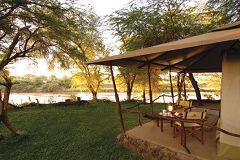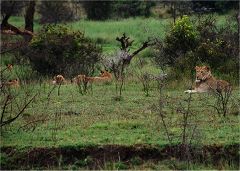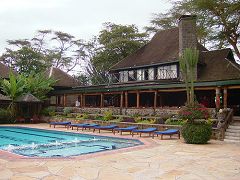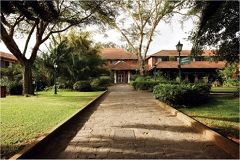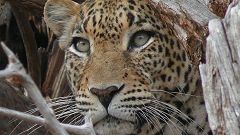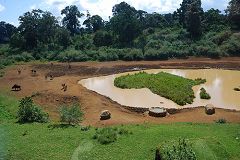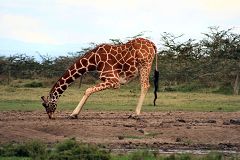 map of Kenya (loading...), the must see in Kenya
map of Kenya (loading...), the must see in Kenya
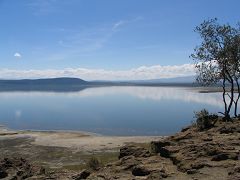
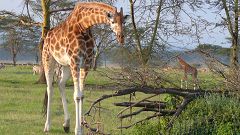
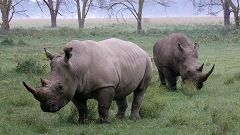
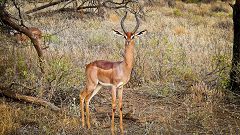
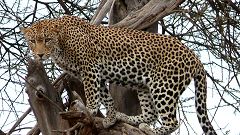
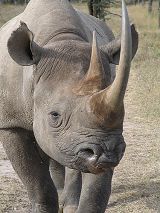
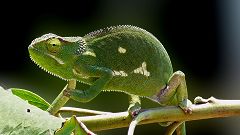
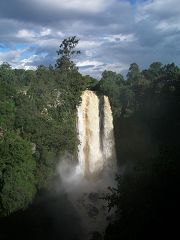 [...]
[...]
The Northern plains are home to nomadic tribes including the Samburu and the Rendille, who move with their camel trains following dry riverbeds across a great semi arid wilderness. Here, rare species such as the Reticulated Giraffe, Grevy?s Zebra and Gerenuk are found.
Day 1 - Nairobi
Arrival in Nairobi Jomo Kenyatta Intl Airport and transfer to town hotel Either
Holiday Inn, Country Lodge, Panafric Hotel, The Norfolk.
Day 2 - Mt. Kenya region
Departure from hotel in the morning and drive towards Mt. Kenya region. Arrive at Serena Mountain Lodge around lunchtime. Lunch at the Lodge. Afternoon game-viewing from the deck and/or nature walk. Dinner & Overnight at Mountain Lodge.
Day 3 - Samburu
After breakfast proceed towards Samburu National Park. Arrive at the park end morning.
Lunch at the Lodge. Afternoon game-drive. Dinner & Overnight. Samburu Sopa Lodge,
Serena Lodge, Samburu Game Lodge,
Larsens private Camp
Day 4 - Samburu
Early morning game-drive followed by breakfast at the Lodge/Camp. After breakfast relax at the camp/lodge and enjoy the view on the river. Lunch at the lodge/camp. Afternoon game-drive along the Uaso river. Dinner & Overnight Samburu National Park.
Day 5 - Sweetwaters
After breakfast departure from Samburu National Park. Drive towards Nanyuki and enter Sweetwaters Sanctuary. Arrive at Sweetwaters tented camp in time for lunch. Afternoon game-drive. Dinner & Overnight at Sweetwaters tented Camp. The camp offers guests some of the fines tented accommodation in Kenya,
personalized service and attention and an abundant game viewing opportunities. From the camp you have a magnificent view across the plains to the snow capped peaks of Mount Kenya. This game sanctuary is the closest reserve to Nairobi with "big five", and has the highest ratio of game-to-area of any park or reserve in Kenya.
Day 6 - Sweetwaters
Early morning game-drive followed by breakfast at the Camp.
After breakfast visit the 200 acre Sweetwaters Chimpanzee Sanctuary, where orphaned chimps are rehabilitated. Visit to Morani - the tame black rhino - and Ereri Multicultural Manyatta. Lunch at the camp. Afternoon game-drive. Dinner & Overnight at Sweetwaters tented Camp
Day 7 - Lake Nakuru
After breakfast drive via Nyahururu (Thomson Falls) towards Lake Nakuru. Picnic lunch enroute. Arrive at Nakuru in the afternoon. Game-drive. Dinner & Overnight at Flamingo Hill tented Camp or Lake Nakuru Lodge
Day 8 - Lake Nakuru
Early morning game-drive followed by breakfast at the lodge/camp. After breakfast relax at the camp/lodge and enjoy the view. Game-drive in the afternoon. Dinner & Overnight at Lake Nakuru
Day 9 - Lake Nakuru, Nairobi
Early morning game-drive followed by breakfast at the lodge/camp. After breakfast drive back to Nairobi. Lunch at Carnivore Restaurant optional, depending on time of flight.
Extension to the coast possible, using local flight to Mombasa.
point of interest
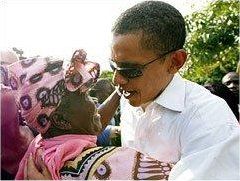
Barack Obama's father origins
Barack Obama was born in Hawaii in the 1961, son of a Kenyan father and American mother (Ann Dunham) who had met at the University in Honolulu. Not a great love story: they split up when Barack was only two. His father returned to Africa and worked as a civil servant for the Kenya's President Jomo [...]

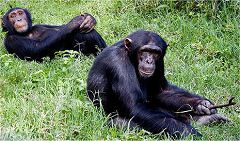
Chimpanzee Sanctuary
The Sweetwaters Chimpanzee was originally estabilished in 1993 in order to receive and shelter a group of three orphaned chimps .In 1995, nine older chimpanzees arrived, followed - at the beginning of 1996 - by a younger cub of ten. The Sweetwaters sanctuary is holding now fourty chimps and the annual cost for taking care of each of them approximates to 6.000 dollars. [photo: Nick Fraser]

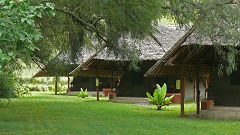
Flamingo Hill tented Camp
The twenty-five tents of the camp are all furnished with the understated luxury required by the modern traveler. Decorated with natural natural woods, wrought iron and crisp cottons each tent has been meticulously planned to maximise comfort.

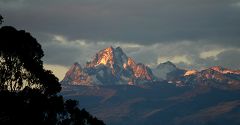
Mount Kenya
Mount Kenya - actually, an extint volcano - is the highest top in Kenya (5.200 meters) and the second highest in Africa, after Kilimanjaro (Tanzania). Its northern flanks across the Equator. The national park was established in 1949 and was inscribed by UNESCO as a World Heritage Site in 1997.

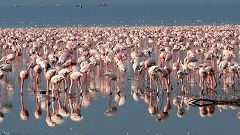
Flamingos at Lake Nakuru
Lake Nakuru national Park is the home to over a million flamingoes. Fleets of Lesser and Greater Flamingoes line the shores of Lake Nakuru giving it a pinkish appearance. Besides flamingoes, Lake Nakuru is home to other water birds including a variety of terrestrial birds numbering about 450 species in total.


White rhino at Lake Nakuru
Both the black and white species of Rhinoceros are in fact gray. The white rhino name is a corruption of the Afrikaans word for wide. The wide refers to the white rhino's broad upper lip that is designed for grazing.

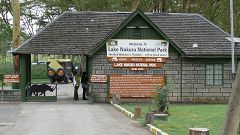
Lake Nakuru National Park Main Gate
Lake Nakuru National Park is the only park in Kenya that is completely fenced since it is located at only 4 km from Nakuru, the fourth largest town of Kenya

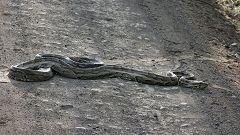
Python
Game-driving through the Lake Nakuru National Park, large sized pythons can often be seen as they're crossing the roads or dangling from trees.

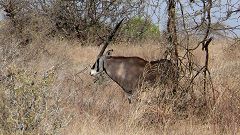
Orix
Orix are highly skilled in finding water and they dig for it in dry river beds. If they can't drink plain water, they can get it from their food (including things such as wild melon). It is believed that the Oryx may have given rise to the myth of the unicorn, since from the side it sometimes appears as though it only has one very long spiral horn. Just like in this picture.


Impala
Females of impala are used to form into harems with their young. Eeach harem is surveilled by a single male who fights other males to defend his group and territory. This can be a very exhausting process and often after the breeding season, goes back to a bachelor herd for a period of time. [photo: Michael Frank]

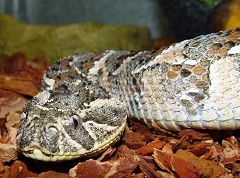
Puff adder
The Puff Adder is one of the most common snakes in Africa. It gets its name from its habit of inflating its body and emitting a deep, low warning hiss to warn intruders to stay away. Its venom is strongly hemotoxic, destroying bloods cells and causing extensive tissue damage. It is largely nocturnal, hunting at night and seeking shelter during the day's heat. [photo: Michael Frank]

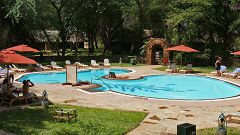
Samburu Game Lodge
The Samburu Game Lodge is surrounded by a pristine riverine forest on the western bank of the Uaso River. It's 857 meters above sea level. Large herds of elephants are seen along the rivers banks which are much favoured by crocodiles.

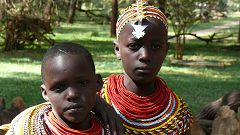
Samburu Game Lodge Cultural Village
The guests of the lodge are given the opportunity to take a tour of the Cultural Village. They are introduced to all aspects of Samburu culture. A spoken journey through Samburu traditions including dances for both women and moran, and Naapo evening meeting for men. The different costumes worn by both girls and women are also explained.


Leopard
Many reserves have all the big five - lion, leopard, elephant, rhino and buffalo - but it's not that easy to see them all, particularly leopard. Leopards are nocturnal, secretive and well camouflaged, but there are some reserves where they are more easily spotted than others. Samburu is one of these places.

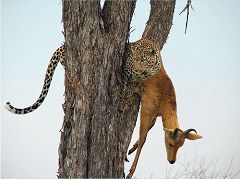
Leopard
A leopard and his kill; a male reedbuck noticeable by curved horns pointing forward [photo: Laura Helsdon]

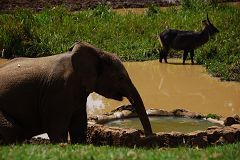
Serena Mountain Lodge
An elephant is drinking at the well near the waterhole in front of the Serena Mountain Lodge [photo: HawBone]

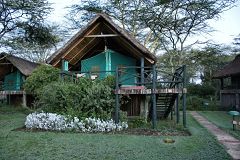
Sweetwaters Tented Camp
The Sweetwaters Tented Camp is located within the Ol Pejeta Conservancy Area. The camp is 25 kilometers west from Nanyuki, in Laikipia District. Sweetwaters is one of only four private game reserves in Kenya and features privileged seclusion and private game viewing. Thanks to its private status it also allows such unforgettable pleasures as night game drives and guided bush walks. [photo: Sinthrex]


Ol Pejeta Conservancy
Ever since 1974, Morani, a tame black rhino, lives in its own sanctuary within Ol Pejeta Conservancy, located few kilometers away from the Sweetwaters Tented Camp. The young rhino was brought to the ranch after some poachers killed its mother. [...] [photo: Patty Chang]


Thomson falls
Thomson's Falls originate where the Ewaso River plummets 75 metres into a boulder-strewn gorge discovered in 1880 by the explorer Joseph Thomson. [...]

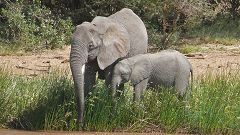
Elephants are refreshing at Uaso river
Uaso stands for brown water (river) in the local Samburu tribe's language. Huge herds of elephants are likely to be seen drinking and cooling off along the banks.

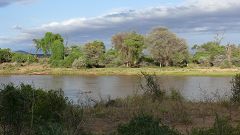
Uaso river
The Samburu area is very dry with a lot of scrub and some acacia trees, except along the banks of the quiet Uaso Nyiro river where there's a narrow stripe of doum palms which contain and shelter a lot of wildlife. The Uaso flows through three great northern reserves, Samburu, Buffalo Springs and Shaba.

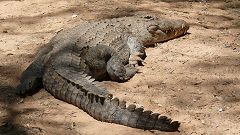
Crocodile at Uaso river
Crocodiles are typical inhabitants of Uaso river. They are able to survive through dry spells by burying themselves in the mud. During the hottest hours of the day they're used to keep their mouths wide open to cool themselves down. Since their digestive system can handle rotting meat from old carcasses, they are very effective at waste disposal (unlike many other carnivores which require fresh meat).


 ...contact
...contact